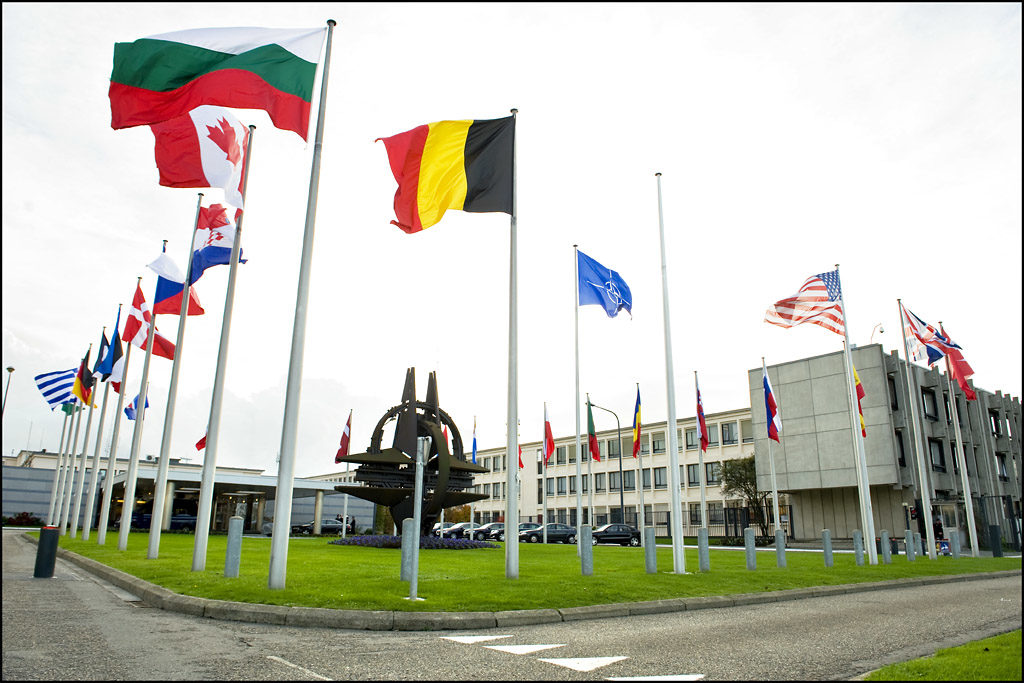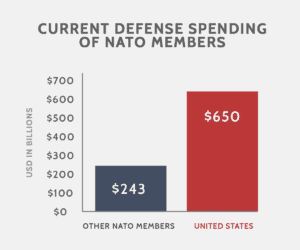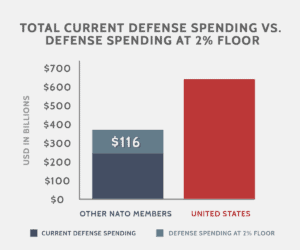Research
May 4, 2016
NATO Defense Spending: Cooperation and Contributions to Transatlantic Security

Summary
- If every North Atlantic Treaty Organization (NATO) member spent at least 2 percent of GDP on defense, it would mean an additional $116 billion in security spending within the alliance.
- Only five of 28 NATO members currently meet the goal of spending 2 percent of GDP on defense.
- The transatlantic alliance faces two major threats: continued challenges from skeptics who question its relevance and diminished defense budgets in a time of fiscal austerity.
Introduction
NATO has served as the cornerstone of peace and security in Europe since its founding in 1949. Initially created as a counterweight to Soviet aggression, the alliance has had to adapt to a post-Cold War world by reinventing its mission, goals, operations, and structure. In the past twenty years, NATO has evolved to meet new threats, including terrorism, humanitarian crises, and cyber-attacks, extending the organization’s presence beyond traditional European borders.
Despite these changes, NATO continues to face questions on both sides of the Atlantic about its relevance and usefulness. At the same time, fiscal insecurity, budget cuts, and austerity measures have constrained defense spending in both Europe and North America, further complicating questions about the future of the alliance.
Republican presidential frontrunner Donald Trump recently highlighted NATO’s budget problems in his major foreign policy address, saying that America’s allies “are not paying their fair share.” Trump further asserted that if NATO members do not meet their military spending commitments, the United States “must be prepared to let these countries defend themselves.”
While NATO does have fiscal challenges, the policy prescription that the United States should simply abandon this important alliance is misguided. NATO remains an indispensable mechanism for deterring Russian aggression and guaranteeing transatlantic stability and security.
This paper addresses the issues of cost-sharing within NATO and examines the outlook for transatlantic security spending if all members met the budget goals. The United States should exercise leadership to encourage European allies to invest in NATO—not forsake it.
Overall Defense Spending Among NATO Members
In 2015, the United States spent more on overall defense than all other NATO members. The U.S. defense budget accounts for 73 percent of total alliance military expenditures. This is not surprising, given America’s unique security commitments around the world as a global leader. According to NATO figures, the United States spent $650 billion on defense expenditures in 2015, while the other NATO members spent a total of $243 billion, as shown in the chart below.
 Source: NATO
Source: NATO
NATO Contributions
Defense spending within a country’s domestic budget should not be confused with NATO contributions. As the largest NATO contributor, the United States currently accounts for 18 percent of all NATO contributions, as shown in the chart below. The other largest contributors (in order) are Germany, France, the United Kingdom, Italy, and Canada. A recent report by an independent Dutch auditing organization revealed that the United States contributed $1.7 billion to NATO in 2014, while the other NATO members contributed a total of $7.8 billion.
 Source: Netherlands Court of Audit
Source: Netherlands Court of Audit
The 2 Percent Pledge
In 2006, defense ministers of NATO member states collectively pledged to spend at least 2 percent of each country’s GDP on defense. At the time of the pledge, six countries were already spending at or above the 2 percent level: Bulgaria, France, Greece, Turkey, the United Kingdom, and the United States. Shortly after other countries began to increase defense budgets, the 2008-2009 global financial crisis forced most alliance members to cut defense spending and limit NATO contributions.
In recent years, new threats to global security emerged. As civil unrest gave way to public protests across the Middle East and North Africa, the promise of the Arab Spring soon subsided. In 2011, Syria devolved into civil war. By 2012, governments in Tunisia, Egypt, Libya, and Yemen had been overthrown. In 2013 and 2014, the Islamic State emerged as a distinct and uniquely brutal terrorist organization, declaring a caliphate and conquering significant territory in Iraq and Syria. And yet, overall European defense spending continued on its downward trajectory.
Then, in 2014, Russia invaded Ukraine’s eastern territories and annexed Crimea, bringing a new sense of urgency to the European security environment. During the NATO Wales Summit that year, 26 of the 28 NATO members renewed their pledge to increase defense spending to 2 percent of each country’s GDP over the next 10 years.
The 2 percent pledge is a target for defense spending within the country’s domestic budget and does not refer to a member’s NATO contribution. The organization determines each member’s cost-share contribution using proportional ratios based on the size of a country’s GDP. The countries that financially contribute most to NATO are those with the largest economies, first and foremost the United States. Although the cost-share ratios provide a clearer picture of burden sharing by member states, the formulas do not account for the diversity of contributions that countries provide to NATO activities. These contributions can come in many forms, including troops, aircraft, and sea vessels in addition to monetary contributions.
Therefore, the 2 percent pledge cannot provide a complete picture of a country’s contribution to NATO funds or activities. It is, however, useful for assessing a country’s threat perception and its commitment to the collective security of Europe. It is also helpful as a benchmark goal for further strengthening the alliance.
Alliance Security Spending in a 2 Percent World
Today only five of NATO’s 28 members currently spend at least 2 percent of GDP on defense. The United States spends the highest percentage of its GDP on defense, at 3.6 percent. In Europe, Greece spends 2.4 percent, Poland spends 2.2 percent, the United Kingdom spends 2.1 percent, and Estonia spends 2.0 percent.
In recent months, emerging threats to European security have caused many governments to reconsider spending priorities. As a result, total European defense spending has actually increased by an average of 8.3 percent in the past year, according to a recent report.
Central and European states on Russia’s doorstep have primarily fueled this increase, boosting their regional defense spending by 19.9 percent.
The fact remains, however, that only five NATO members currently meet or exceed the 2 percent commitment. The United States should actively encourage all alliance members to meet this goal. If every NATO member spent at least 2 percent of its GDP on defense, the result would be an additional $116 billion in additional military spending within the alliance. The impact on regional and global security would be incalculable.
 Sources: GDP figures from CIA World Factbook; current defense spending from NATO
Sources: GDP figures from CIA World Factbook; current defense spending from NATO
Conclusion
A stable, secure Europe directly affects U.S. global national security interests. Transatlantic solidarity allows the United States and NATO countries to multiply the impact of trade investments, diplomatic exchanges, and security operations. Increases in European defense spending would demonstrate a stronger commitment to collective security, embolden the alliance, and ultimately lead to a more responsive security environment.
At the beginning of this year, NATO Secretary-General Jens Stoltenberg argued that 2015 was a year of action for the alliance. NATO more than doubled the size of its response force, increased its presence in Europe’s east, and partnered with the European Union to ensure greater regional security. Yet, with the long list of challenges facing the alliance, more remains to be done. “Now,” the secretary stated, “is the time to invest.”
In the face of a revanchist Russia, a weakened European Union, and the increasing threat of extremism at home and abroad, cooperation between the United States and Europe has never been more necessary.










